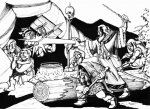Well, when you have players who don't assume every encounter should be automatically won, then it isn't a problem. They tend to be more cautious in their approach.
Several times over the past week or so I've seen this idea of "encounters thst should be automatically won". I'm not sure where it comes from - but here is a comment from Gygax, on p 179 of his DMG:
Number of creatures encountered should be appropriate to the strength of the encountering party.
In other words, the idea that "encounter building" involves some constraint of fairness or reasonableness is hardly new.
The main difference I see between then and now is that Gygax assumed that, with the exception of random encounters (which is the context in which the above advice is given), the
players will be choosing what challenges their PCs confront (by scouting out the dungeon, and choosing which targets to hit); whereas most contemporary D&D play seems to assume that the
GM will choose what challenges the PCs confront. The old idea of a large dungeon complex with mostly static encounters (monsters in rooms) - and idea that one can see at work in the Tucker's kobolds editorial - is mostly gone.
And another thing: is the game better when the players (and their PCs) adopt a cautious approach? Personally, I don't think so. Conan, mostly, is reckless, not cautious. Aragorn went boldly into the Paths of the Dead - he didn't push in front with a 10' pole. My own view is that cautious, 10' pole play tends to be boring, and that more forthright play tends to be more exciting at the time and more memorable after the event.
I don't think that makes me some sort of bad roleplayer!




